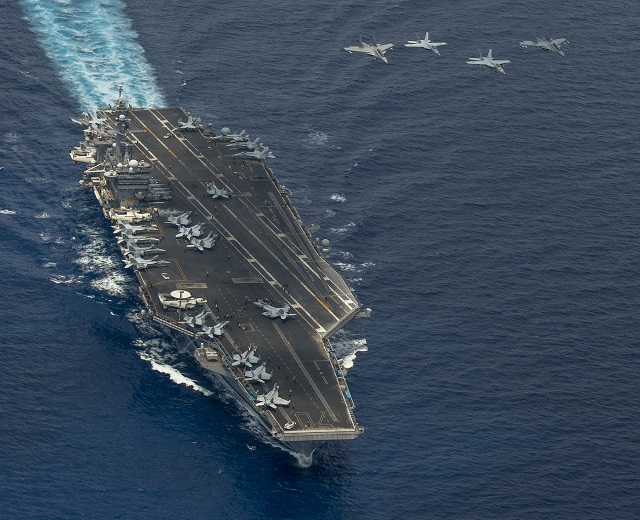 Two
F/A-18 Super Hornets and two Royal Malaysian Air Force Su-30MKM fly in
formation above the aircraft carrier USS Carl Vinson (CVN 70). (U.S. Navy
photo by Mass Communication Specialist 2nd Class John Philip Wagner, Jr.) Two
F/A-18 Super Hornets and two Royal Malaysian Air Force Su-30MKM fly in
formation above the aircraft carrier USS Carl Vinson (CVN 70). (U.S. Navy
photo by Mass Communication Specialist 2nd Class John Philip Wagner, Jr.) |
|||
According
to Capt. Beau Duarte, Programme Manager of Unmanned Carrier Aviation Programme
Office (PMA-268), “this marks the start of a phased implementation
of the MQ-XX system on an aircraft carrier. The lessons and ground-breaking
work done here will go on to inform and influence future installations
on other aircraft carriers.” The MQ-XX programme was formerly known as Carrier Based Aerial Refueling System. It is an effort to integrate unmanned air vehicles in an aircraft carrier’s capabilities. The plan is to include precision striking, persistent ISR and air-refueling capabilities. The House Armed Services Committee decided, in the H.R. 4909 – FY17 National Defense Authorization Bill – Subcommittee on Seapower and Projection Forces, that the Navy must continue with the UCLASS (Unmanned Carrie Launched Surveillance and Strike) programme including airborne tanking as an additional capability. Nevertheless, the US Navy is interested in moving forward with the air refueling and ISR capabilities first. Following the success of the X-47B UCAS Demonstrator phase, its leadership plans to initially develop those two capabilities, as they are considered to be easier, allowing the Service to implement its plan for the first unmanned capability to be ready by 2018. Rear Admiral James Loeblein, Commander of Carrier Strike Group 1 (CSG 1), said on the occasion of the milestone: “Having a UAV asset that provides persistent, potentially 24/7, surveillance coverage for the strike group is a game changer. Putting additional ISR capacity into the warfare commander’s hands increases the flexibility and warfare capability of the entire strike group.” Furthermore, this incremental step will “extend performance, efficiency and enhance safety of aerial refueling and reconnaissance missions that are expending valuable flight hours on our strike-fighter aircraft, the F/A-18 Echoes and Foxtrots” according to Capt. Karl Thomas, Carl Vinson’s commanding officer. |
|||
US Navy Installed UAV C2 Centre Aboard Aircraft Carrier USS Carl Vinson for MQ-XX
- Posted On










